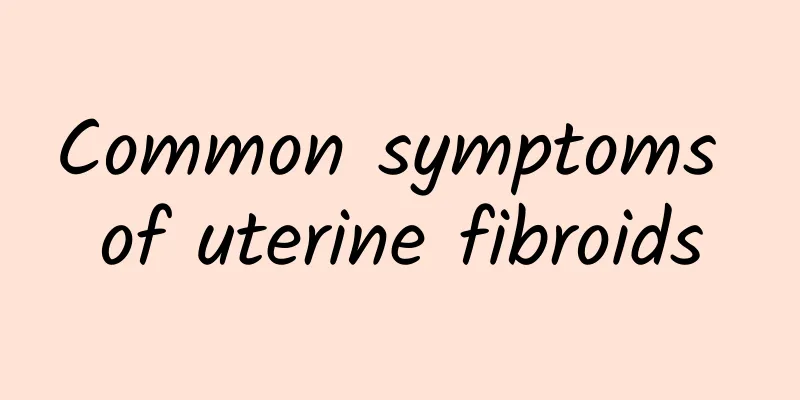What causes cervical erosion? How can cervical erosion be cured?

|
Cervical erosion refers to the ectopic columnar epithelium of the cervix, which is not a true erosion. When the epidermis of the external cervical os is shed and replaced by another epithelial tissue of the cervical os, the new epithelium covering the surface is thin, and even the blood vessels and red tissue below can be seen, which looks like erosion. It is one of the physiological changes of the cervix, not a pathological change. The wrong name "cervical erosion" has been "canceled" in the medical obstetrics and gynecology textbooks in 2008 and replaced by the physiological phenomenon of "ectopic columnar epithelium of the cervix". Physiological ectopic columnar epithelium of the cervix is more common in adolescence, women of childbearing age with strong estrogen secretion, oral contraceptives or pregnancy. Due to the effect of estrogen, the squamous-columnar junction moves outward, and the local cervix changes in appearance like erosion. Symptoms include menstrual disorders, vulvar itching, bleeding during sexual intercourse, increased leucorrhea, stickiness, odor, and often purulent, and may be accompanied by pain in the lower abdomen and lumbosacral region and bladder irritation. Patients with more severe erosions may have varying degrees of purulent and bloody secretions, typically with fresh bloody secretions after sexual intercourse. There are three main levels of symptoms: 1. Mild cervical erosion: When the eroded area is less than 1/3 of the entire cervical area, it is mild cervical erosion. The symptoms are only increased leucorrhea and yellow color. Depending on the pathogen, the leucorrhea may also change in quality, quantity and color. 2. Moderate cervical erosion: The erosion area accounts for 1/3 to 2/3 of the cervical area. Symptoms include increased leucorrhea, yellow color, sticky and smelly, and irritation to the vulva causing itching. 3. Severe erosion: Severe cervical erosion occurs when the erosion area accounts for more than 2/3 of the entire cervical area. Leucorrhea increases in amount, becomes yellow in color, is sticky and has a foul odor. Inflammatory leucorrhea can cause itching of the vulva due to long-term irritation. Other symptoms include urinary tract symptoms. Once the inflammation of cervical erosion spreads to the bladder triangle or around the bladder, frequent urination and difficulty urinating will occur. Cervical erosion was mistakenly considered a pathological phenomenon in the past. During a gynecological examination, doctors can sometimes see a yellow part in the vagina, which is the appearance of the cervix. In the cervix, there are two different types of epithelial cells: squamous cells close to the vagina and columnar cells close to the uterus. The two types of epithelial cells are different in appearance: the central part, which looks a bit like an "eroded" cervix, is the part covered by columnar epithelium, while the cervix, which is relatively smooth on the outside, is the part covered by squamous epithelial cells. The columnar epithelial cell area and the squamous epithelial cell area are in a state of dynamic equilibrium. The junction area is medically named the "squamo-columnar junction", which is also a high-incidence area for cervical cancer. Columnar epithelium is easily affected by estrogen. Before puberty, women's ovarian function is not perfect, estrogen is low, and the columnar epithelium is close to the inside of the cervix, which is not easy to be found. After menstruation, the columnar epithelium develops more toward the outside of the cervix under the influence of estrogen, so it is easy to see "eroded" columnar epithelium at the cervical opening. After menopause, women's estrogen levels decrease, and the columnar epithelium gradually retreats into the cervix, so when you check, the "erosion" will not be visible. So, in essence, the so-called "cervical erosion" is actually the eversion of the columnar epithelium (cervical ectropion). In medical textbooks in mainland China before 2008, there was a so-called cervical erosion diagnosis (called mild, moderate and severe, and the size of the range was considered to be the severity of the inflammation. An area less than 1/3 is mild, 1/3-2/3 is moderate, and more than 2/3 is severe). Medical textbooks starting from 2008 believe that cervical columnar epithelium ectopia is the eversion of columnar epithelium to varying degrees after being affected by estrogen, which is a normal physiological phenomenon. The specific reasons are: Unclean sexual life (20%): Young women’s premarital sexual behavior is mostly kept secret. In addition, young people do not have a stable source of income and cannot create a stable and clean sexual environment, so the probability of disease will be greatly increased. Multiple artificial abortions (30%): Premarital sex leading to multiple abortions, diagnostic curettage, cervical dilation and other gynecological surgeries may lead to cervical injury or inflammation, and eventually cause cervical erosion. Excessive cleaning (15%): There are many feminine cleaning products on the market. If you choose the wrong ones and use a high concentration of disinfectant to flush the vagina, it will not only affect the growth of normal vaginal flora and reduce its ability to inhibit bacteria, but also cause varying degrees of cervical epithelial damage and eventually erosion. Premature sexual activity and too many sexual partners (16%): Premature sexual activity, frequent changes of sexual partners, and excessive sexual activity are the causes of cervical erosion that cannot be ignored, laying hidden dangers for young women. Daily prevention of cervical erosion 1. Eat a light diet with more fruits, vegetables and light food, and make sure to get enough rest. 2. Pay attention to health care during key periods, because many women are very susceptible to this disease, so you must pay attention to health care, especially during menstruation, pregnancy and postpartum period. 3. Keep the vulva clean. It is very necessary to keep the vulva clean, and you should go to the hospital for regular check-ups to achieve early detection and early treatment, while avoiding unclean sexual intercourse. 4. Surgical treatment can be used if necessary. Depending on the condition, surgical treatment can be used if necessary. 5. Have regular gynecological examinations to detect cervical inflammation and provide timely treatment. Health Education 1. Pay attention to sexual hygiene, control your sex life appropriately, and resolutely put an end to extramarital sex and avoid sexual intercourse during menstruation. 2. Take timely and effective contraceptive measures to reduce the incidence of artificial abortion and induced labor, so as to reduce the chance of artificial trauma and bacterial infection. 3. Those with short menstrual cycles or prolonged menstrual periods should be actively treated. 4. Prevent instruments from damaging the cervix during delivery. 5. If cervical laceration is found after delivery, it should be sutured promptly. 6. Have regular gynecological examinations to detect cervical inflammation and provide timely treatment. There are generally three types of cervical erosion: mild, moderate, and severe. If a woman is of childbearing age and has mild cervical erosion and no symptoms, she does not need to be treated. There are some physiological factors that cause erosion. If it is moderate to severe erosion, it must be confirmed in a regular hospital. Except for cervical cancer, some physical treatments can be performed. Microwave, laser, freezing, and radiofrequency ablation are more commonly used. These treatments are more effective. Generally, one treatment may be good, and two treatments may be enough. Drug treatment is suitable for patients with small erosion surface, shallow inflammatory infiltration or limited conditions. 25% silver nitrate, chromic acid and other local corrosion are used locally. The vagina should be irrigated before medication, and then wiped dry with dry cotton balls, and the normal vaginal mucosa should be protected with cotton balls. Drugs can also be applied locally with Aibo therapy (preferably by a doctor) or vaginal suppositories are applied by yourself. Drug treatment is mainly suitable for non-pregnant patients with mild to moderate cervical erosion, but drug treatment generally takes a long time and costs more. Many Chinese herbal powders also have certain therapeutic effects, but they are prohibited from use during menstruation and pregnancy. Do not have sexual intercourse or take a bath after taking the medicine Any medication cannot be used for a long time: especially in the vaginal environment, long-term medication can easily lead to candidal vaginitis, that is, dysbacteriosis. Therefore, it is not suitable to use medication for a long time if there is severe cervical erosion, and even if it reaches severe cervical erosion, long-term medication will not be good, so it is better to eliminate the immediate inflammation and then do physical therapy. Western medicine treatment of cervical erosion: 1. Drug treatment - less side effects, more suitable for women who have not given birth. The most common drugs for treating cervical erosion abroad are Shadier Gel, Huijian combination, and external medication Xiaomi suppositories, which are effective but relatively expensive. 1. Carefully apply 10-30% silver nitrate solution or 10% iodine to the affected area with a cotton swab. After applying silver nitrate, apply physiological saline to convert excess silver nitrate into non-corrosive silver chloride. Apply twice a week, 4-6 times as a course of treatment, and repeat if necessary. 2. Use a cotton swab to dip the potassium dichromate solution and carefully apply it to the affected area. Apply the medicine once after the menstruation is over, and repeat it once after the next menstruation. For those with larger erosions, the effect is sometimes better. Before applying the medicine, wipe the cervical mucus with 0.1% chlorhexidine, and place 2 cotton balls in the posterior fornix to prevent the medicine from flowing down and burning the vaginal mucosa. After that, take out the cotton balls and wipe the application area with a 75% alcohol cotton swab (formula: 10g potassium dichromate, 75ml concentrated sulfuric acid, add water to 100ml). 2. Physical therapy - suitable for patients with moderate and severe cervical erosion. Commonly used methods include electric ironing, laser therapy, and cryotherapy. The disadvantage is that the side effects are large, which may cause the sensitivity of the vaginal wall nerves to decrease, affecting the quality of sexual life. In addition, it is easy to relapse after treatment. Many people have heard that scars on the neck after physical therapy will affect pregnancy, which makes many infertile women refuse physical therapy. So how should infertile women with cervical erosion be treated? First of all, we need to look at the degree and nature of the erosion. Cervical erosion is divided into three degrees: mild, moderate, and severe according to the depth of the lesion. If it is mild and superficial erosion, even if the erosion surface is large, if the erosion depth is shallow and there is not much leucorrhea, it can be temporarily left untreated. If it is moderate or above papillary erosion, cancer prevention examinations and treatment must be done. As long as you pay attention to the treatment range not affecting the cervical canal during physical therapy, you don't have to worry too much. This depends on the doctor's correct diagnosis of the disease and his proficiency in the operation. Of course, it is a bit risky, so it is best for women who have not given birth to take drug treatment. 3. Surgical treatment - If the above treatment is ineffective, or there is cervical hypertrophy, or the erosion is deep and wide, and the cervical canal is involved, cervical conization or total hysterectomy can be considered. However, surgical treatment is rarely used now. However, the worst consequence of surgery is that it can cause infertility in women! You need to choose carefully! In addition, cervical erosion is a manifestation of cervicitis, and the two do not need to be strictly distinguished. The cervix, endocervical canal, and vagina are all part of the extragenital channel. For inflammatory lesions in various parts of the extragenital channel, there is a disinfection pen that uses ultraviolet light that can be used. It is effective and harmless to cervicitis (erosion). However, there is a type of cervicitis called Nabothian cyst, which is a cystic protrusion formed by tissue hyperplasia. The disinfection pen has an inhibitory effect on the proliferation of Nabothian cysts, but those with higher cystic protrusions must be surgically removed. Traditional Chinese medicine treatment of cervical erosion: Chinese medicine treatment: ① 9g of May frost, 6g of wheat bran grass, 5g of astragalus, and an appropriate amount of sheep tan. Take it as a decoction, which can also be used for trichomonas vaginitis. ② Yunnan Baiyao 10g. Mix it with glycerin to make an ointment, apply the ointment on a cotton ball with a thread, insert it into the vagina, close to the cervical erosion, and after 12 hours, pull the thread to remove the cotton ball (the vagina should be rinsed before applying the medicine). Apply the medicine once every 3 days, 5 times as a course of treatment, and avoid sexual intercourse during the medication period. Recipe: 1. Egg white can treat cervical erosion [Prescription] 1 fresh egg. [Preparation and Usage] Wash the egg with disinfectant, break it and take out the pure egg white. After flushing the vagina with potassium permanganate solution, dip the thread-tied gauze cotton ball in the egg white and fill it into the cervical opening (leave the thread of the cotton ball outside the vaginal opening to facilitate the removal of the cotton ball). Take it out after 5 hours and change it 1 to 2 times a day. Stop treatment when menstruation comes. [Effects] Clears away heat, detoxifies, and reduces swelling. Used to treat cervical erosion. It is very effective for cervical erosion and bleeding. 2. Fig leaves treat cervicitis [Prescription] 1 handful of fig leaves (double the amount for fresh figs). [Preparation and Usage] Boil fig leaves in 1 basin of water until half a basin is left. Use it as a sitting bath while it is hot, once a day. 【Effects】 Clears away heat and detoxifies. Used to treat chronic cervicitis. 3. Pig gallbladder and pomegranate peel treat cervical erosion [Prescription] 5 to 10 pig gallbladders (about 30 grams after drying in the shade), 60 grams of pomegranate peel. [Preparation and Usage] Grind into fine powder, mix with appropriate amount of peanut oil into paste, bottle and set aside. Before use, wash the affected area with warm water, wipe dry cervical secretions, and then dip the cotton ball with thread tie into the medicine and insert it into the cervical erosion. Use once a day for multiple times. 【Effects】Detoxification, insecticide, tissue regeneration. Strong antibacterial effect. Mainly used to treat cervical erosion. 4. Gallnut for the treatment of cervical erosion [Prescription] 60 grams of gallnut. [Preparation and Usage] Grind the gallnut into extremely fine powder, add appropriate amount of water, put it in a container and stew it into a paste, then apply it to the affected area. 【Effect】Treatment of cervical erosion. 5. Lithospermum officinale oil for the treatment of cervical erosion [Prescription] Lithospermum officinale and appropriate amount of sesame oil. [Preparation and Usage] Put the lithospermum officinale in sesame oil and soak it for 7 days. Or boil the sesame oil and soak the lithospermum officinale in the boiling oil until it turns rose color. Apply it to the cervix once a day, and insert a cotton ball with thread into the vagina, and remove it on the second day. 【Effect】Treatment of cervical erosion. 1. Female friends with cervical erosion should pay attention to a light diet, eat more lean meat, chicken, eggs, quail eggs, crucian carp, turtle, white fish, cabbage, asparagus, celery, spinach, cucumber, winter melon, mushrooms, tofu, kelp, seaweed, fruits, etc., and pay attention to rest; 2. Care should be taken to keep the vulva clean, but it is strictly forbidden to flush the inside of the vagina. Do not use disinfectants or various cleaning agents to frequently flush the vulva and vagina. 3. Pay attention to sexual hygiene, properly control sexual life, resolutely put an end to extramarital sex and avoid sexual intercourse during menstruation. During the treatment period, since the wound surface has not been completely healed, it is not suitable to have sexual life, and after treatment, it is not suitable to have sexual life too frequently. 4. Take timely and effective contraceptive measures to reduce the incidence of artificial abortion and induced labor, so as to reduce the chance of artificial trauma and bacterial infection and prevent the cervix from being damaged by instruments during delivery. 5. Have regular gynecological examinations to detect cervical inflammation and provide timely treatment. 6. If there is mild cervical erosion, such as increased vaginal discharge, a change in color from transparent to white or yellowish white, pus or blood, or an odor, you should be alert and go to the hospital for treatment in time. 7. After cervical erosion surgery, the body is weak and prone to sweating. Therefore, water should be replenished in small amounts and multiple times to reduce water evaporation; sweat excretes more water-soluble vitamins, especially vitamin C, vitamin B1, and vitamin B2, so you should eat more fresh vegetables and fruits. This is also helpful to prevent constipation. 1. Stew 1 black-bone chicken and eat it regularly. It is suitable for all kinds of cervical erosion, especially vaginal bleeding. 2. Add 5g of ginseng when the chicken is cooked and boil it for a few seconds. Or add 30g of Codonopsis pilosula when the chicken is cooked. Drink the soup and eat the chicken. Suitable for all kinds of cervical erosion. 3. 500g mutton, 50g angelica, 3g ginger, stew over low heat, drink soup and eat mutton. Suitable for cervical erosion, aversion to cold, pale tongue, and anemia. 4. 500g of squid, prepared as you like, and taken. Suitable for all kinds of cervical erosion accompanied by red and white vaginal discharge. 5. Boil 50g of cuttlefish and 30g of madder, drink the soup and eat the cuttlefish. Suitable for cervical erosion accompanied by vaginal bleeding. 6. 500g lean pork, 30g golden needle vegetable, 30g angelica, cook together. Suitable for cervical erosion, physical weakness, and vaginal bleeding. 7. 50g abalone, 10 raw hawthorns, simmer until the abalone is rotten, drink the soup and eat the fish. Suitable for cervical erosion and vaginal bleeding. 8. 50g of Astragalus and 15g of Angelica, decoct in water to extract juice and cook into porridge, eat regularly. Suitable for fatigue caused by cervical erosion. Also suitable for fatigue caused by various physical treatments for cervical erosion. 9. 500g cucumber, 100g coriander, half a garlic, cut into small cubes, mix, and eat from time to time. Suitable for all kinds of cervical erosion. 10. Slice 2 tomatoes, prepare 2 petals, mince, mix, and eat at any time. Suitable for all kinds of patients with cervical erosion. 11. Steamed pork liver with verbena. 60g fresh verbena (3Dg dry), 60-100g pork liver, wash and cut the verbena into small pieces, slice the pork liver, mix well, put it in a clay dish, steam it and take it. Once a day. 12. Houttuynia cordata stewed with pig lungs. 60g of fresh Houttuynia cordata, about 200g of pig lung, cut the pig lung into pieces, squeeze and wash to remove foam, add appropriate amount of water to make soup, season with a little salt, and drink the pig lung. 1. Eat less sweets, irritating foods, spicy foods, etc. 2. Do not eat mutton, shrimp, crab, eel, salted fish, black fish and other irritating foods. 3. Avoid eating irritating foods, such as chili peppers, wine, vinegar, pepper, ginger, etc. These foods can stimulate congestion of sexual organs and increase menstrual volume. Also avoid eating cold foods such as crabs, snails, and clams. 4. Do not eat spicy or irritating foods, because they will aggravate pelvic congestion and inflammation, or cause excessive contraction of the uterine muscles, which will aggravate the symptoms. Foods that are hot, coagulant, and contain hormones, such as chili, pepper, garlic, onion, ginger, leek, chicken soup, durian, longan, red dates, donkey-hide gelatin, royal jelly, etc. should also be eaten less. |
Recommend
Home care for severe cervical erosion
Cervical erosion can be divided into many differe...
Principles of treatment of pelvic peritonitis
Pelvic peritonitis is a disease that is very harm...
Who in life will have an ectopic pregnancy
Ectopic pregnancy can be prevented through self-p...
Introduction to the hazards of four serious pelvic inflammatory diseases
Many patients with pelvic inflammatory disease do...
Animal study: Celery extract turns obese cells into brown fat
The application scope of regenerative medicine st...
Should I remove my makeup when exercising? Beautiful Doctor: At least do this first...
Finally off work! Many female office workers who ...
What to do with leftovers from the New Year holidays? Dr. Liu Boen: Reheating and eating in the wrong way can lead to weight gain
The Chinese New Year holiday is coming soon. Duri...
Blind use of lotion can also lead to cervical erosion
Cervical erosion is relatively common in daily li...
Can low menstrual flow cause infertility?
It is a common misconception that light menstruat...
What should women eat to improve ovarian function? Doctors recommend two types of food
Only when the ovaries function well can women hav...
Can adnexitis be inherited?
Nowadays, there are more and more genetic disease...
What causes backache during ectopic pregnancy? Is it caused by blocked fallopian tubes?
Ectopic pregnancy is actually a relatively common...
What are the early symptoms of ectopic pregnancy?
Ectopic pregnancy is a very common situation in o...
Patients should pay more attention to the symptoms of cervical erosion
In recent years, the incidence of cervical erosio...
Does your annual fitness plan always fall through? 4 tips to help maintain
It’s time to make new wishes for the New Year. Go...









